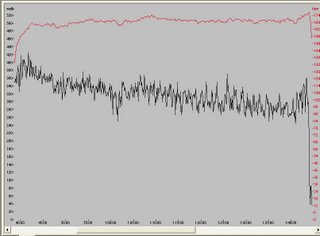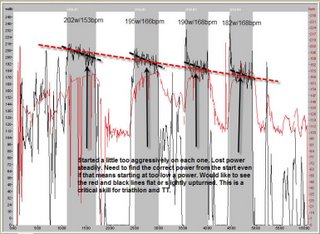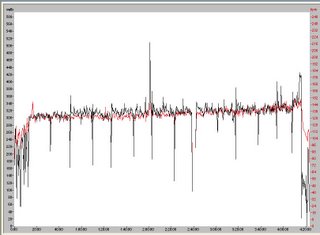More on Negative Splits
 A few weeks ago I wrote about negative splitting a race and the 51-49 principle (the importance of making the first half slightly slower/easier than the second half of a race). The graph on the left is a good example of what happens when you do just the opposite--positive split the course. This is from a 65-minute hill climb done as a bike test. Notice how heart rate (red) stays steady while power (black) drops steadily. The athlete simply went out too fast. This makes for a painful race or workout that is slower than it would have been had he gone out easier.
A few weeks ago I wrote about negative splitting a race and the 51-49 principle (the importance of making the first half slightly slower/easier than the second half of a race). The graph on the left is a good example of what happens when you do just the opposite--positive split the course. This is from a 65-minute hill climb done as a bike test. Notice how heart rate (red) stays steady while power (black) drops steadily. The athlete simply went out too fast. This makes for a painful race or workout that is slower than it would have been had he gone out easier. Patience when racing is hard to learn. The best way to learn it is to rehearse negative splitting in workouts. What most people do in training is what you see in the second chart. This was  four climbs of about 5 minutes each with a descent recovery. The intensity prescribed was just below functional threshold power (FTP). Feeling good at the start of the workout the rider exceeded FTP on the first interval. The black dashed lines show how power tailed off for each work interval. And over the course of the workout each work interval also started at too high of a power level and dropped. By the end of the workout the athlete could not get even close to FTP with interval #4. This was not a productive workout. Bad habits were ingrained and muscular endurance and force were not appropriately challenged.
four climbs of about 5 minutes each with a descent recovery. The intensity prescribed was just below functional threshold power (FTP). Feeling good at the start of the workout the rider exceeded FTP on the first interval. The black dashed lines show how power tailed off for each work interval. And over the course of the workout each work interval also started at too high of a power level and dropped. By the end of the workout the athlete could not get even close to FTP with interval #4. This was not a productive workout. Bad habits were ingrained and muscular endurance and force were not appropriately challenged.
 four climbs of about 5 minutes each with a descent recovery. The intensity prescribed was just below functional threshold power (FTP). Feeling good at the start of the workout the rider exceeded FTP on the first interval. The black dashed lines show how power tailed off for each work interval. And over the course of the workout each work interval also started at too high of a power level and dropped. By the end of the workout the athlete could not get even close to FTP with interval #4. This was not a productive workout. Bad habits were ingrained and muscular endurance and force were not appropriately challenged.
four climbs of about 5 minutes each with a descent recovery. The intensity prescribed was just below functional threshold power (FTP). Feeling good at the start of the workout the rider exceeded FTP on the first interval. The black dashed lines show how power tailed off for each work interval. And over the course of the workout each work interval also started at too high of a power level and dropped. By the end of the workout the athlete could not get even close to FTP with interval #4. This was not a productive workout. Bad habits were ingrained and muscular endurance and force were not appropriately challenged.The take home message here is that you race the way you train. If you want to produce the best times possible in steady state events such as running races, road time trials and triathlons then you need to pace the workouts correctly by negative splitting them. This means you hold back a bit at the start of each interval and try to gradually lift the output as the interval progresses. And you try to make the latter intervals faster or more powerful than the first few intervals. By doing this you ingrain what it takes to produce your best possible race times.
 The third chart is a long ride done in preparation for Ironman Hawaii. Following a short warm up the athlete rode steadily for four hours. Notice how power (black) rises very steadily throughout and heart rate (red) remains coupled very closely to it. This chart is so beautiful it brings tears to my eyes. :) This workout was done five months prior to Ironman Hawaii in which the athlete did a 5:05 bike split. He raced the same way--steady and negative splitting the course. Learn to train this way and you will soon be racing faster.
The third chart is a long ride done in preparation for Ironman Hawaii. Following a short warm up the athlete rode steadily for four hours. Notice how power (black) rises very steadily throughout and heart rate (red) remains coupled very closely to it. This chart is so beautiful it brings tears to my eyes. :) This workout was done five months prior to Ironman Hawaii in which the athlete did a 5:05 bike split. He raced the same way--steady and negative splitting the course. Learn to train this way and you will soon be racing faster.By the way, a power meter on the bike and a GPS device for running makes this much easier to do. Trying to negatively split a workout or race based on heart rate is not always effective, especially when doing intervals.


10 Comments:
Joe,
Thank you for continuing your "series" on negative splits.
Any suggestions on how to appropriately gauge those first intervals while running with GPS?
I'm perpetually the athlete in image #2.
Thanks,
Bill
Bill--The key to this regardless of the technology used is to feel like you're going too slowly. A GPS device can confirm what you are feeling. Of course, it's important to know what your pace should be and go no faster than that.
me thinks your athlete needs to re-calibrate his power meter. Looks like he averaged over 310watts, thats like Torbjorn/Stadler territory!!! Surely not considering he rode 5:05 unless he weighs over 100kg!!
I could be missing something here, so go easy~!
Thanks
David
David--He is 200 lbs and 6'8". Has done 4:50 in Hawaii and usually averages around 280w there.
320 watts for 4 hours and could only pull of a 5:05 bike split is he 10 feet tall and 200lbs
cheers
Got ya it's all making sense now. One strong monster!!
Should you be training at watts which are that much higher than you intend racing??
Thanks
David
David--This was a test to see what he could handle. We decided not to race at that power level as it turns out due to other circumstances which I won't get into here.
Joe, fancinating stuff, I have a couple of questions: can you tell us what the course was like for the third graph and what would the considerations be when riding through hills, mostly in the second half of the ride, where a negative spilt is almost impossible?
Thanks
slb--The 3rd chart came from a relatively flat course. Realize that while 'negative split' implies a time differential, it also applies to effort, power and pace. The bottom line is that you should hold back early in the race by a small amount so that you don't fade late in the race, which is what most athletes do.
Thanks for this! Due to "cardiac drift", I recon you must start with a slightly lower puls, than your "goal puls"?
Example: I will do a Ironman in Sweden in one week from now. If I assume that the race will take around 11 hours - and if I use your tables in the excellent book Total Heart Rate Training - my average puls on the bike should be around 134 bpm* and the run 142 bpm**.
However, if I start my bike and run at 134 and 142 the speed/watt the "cardiac drift" will gradually decrees the speed (i.e. a positive split). Right? So I should rater start around 123 and 132 and gradually increase the puls during the race (so I get a negative split during the race)?
If so, what do you recommend? Is -10 bpm a good "target" puls in the first half of the bike and run during an Ironman, and then gradualle increase the puls when the "cardiac drift" kicks in?
Regards
TriLarsson (Sweden)
* 83% out of threshold puls on the bike 162
** 87% out of threshold puls on the run 165
Post a Comment
<< Home